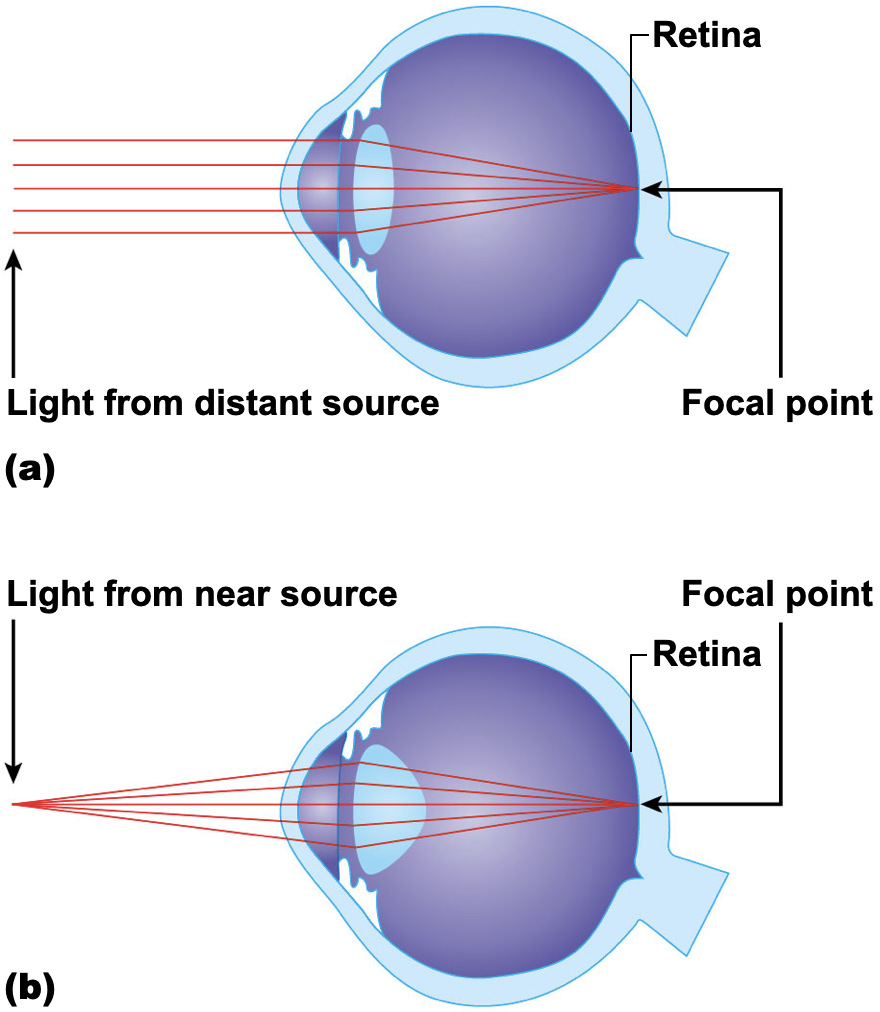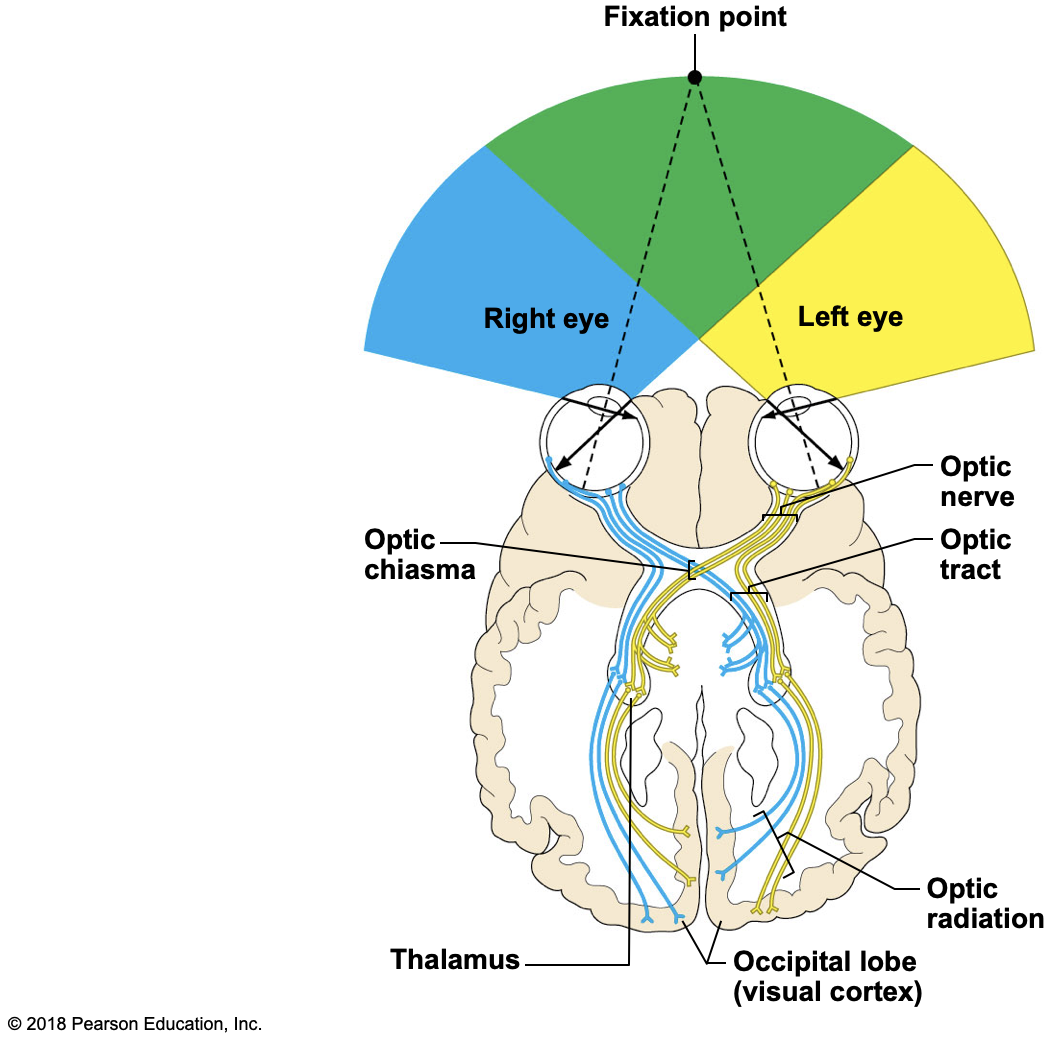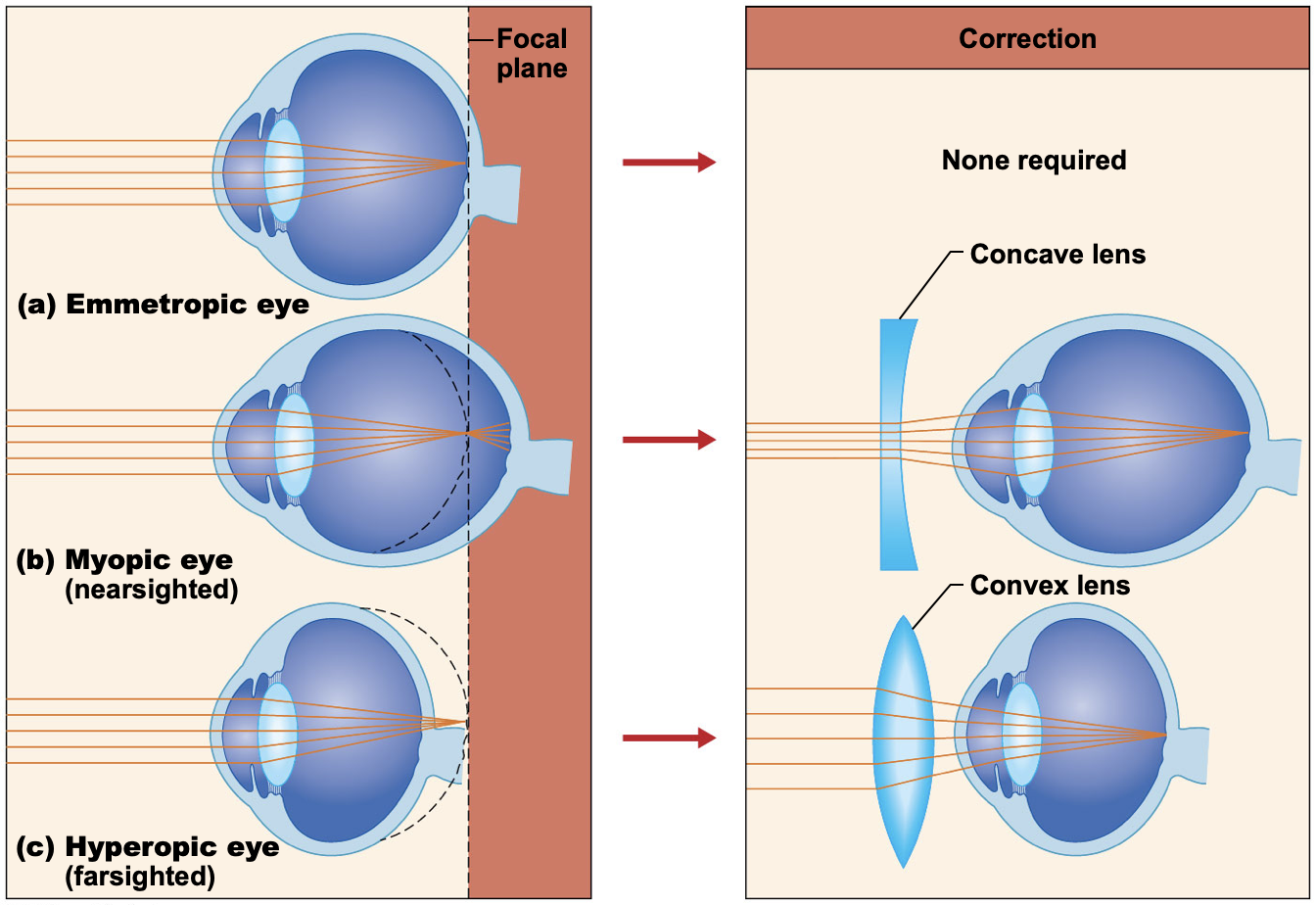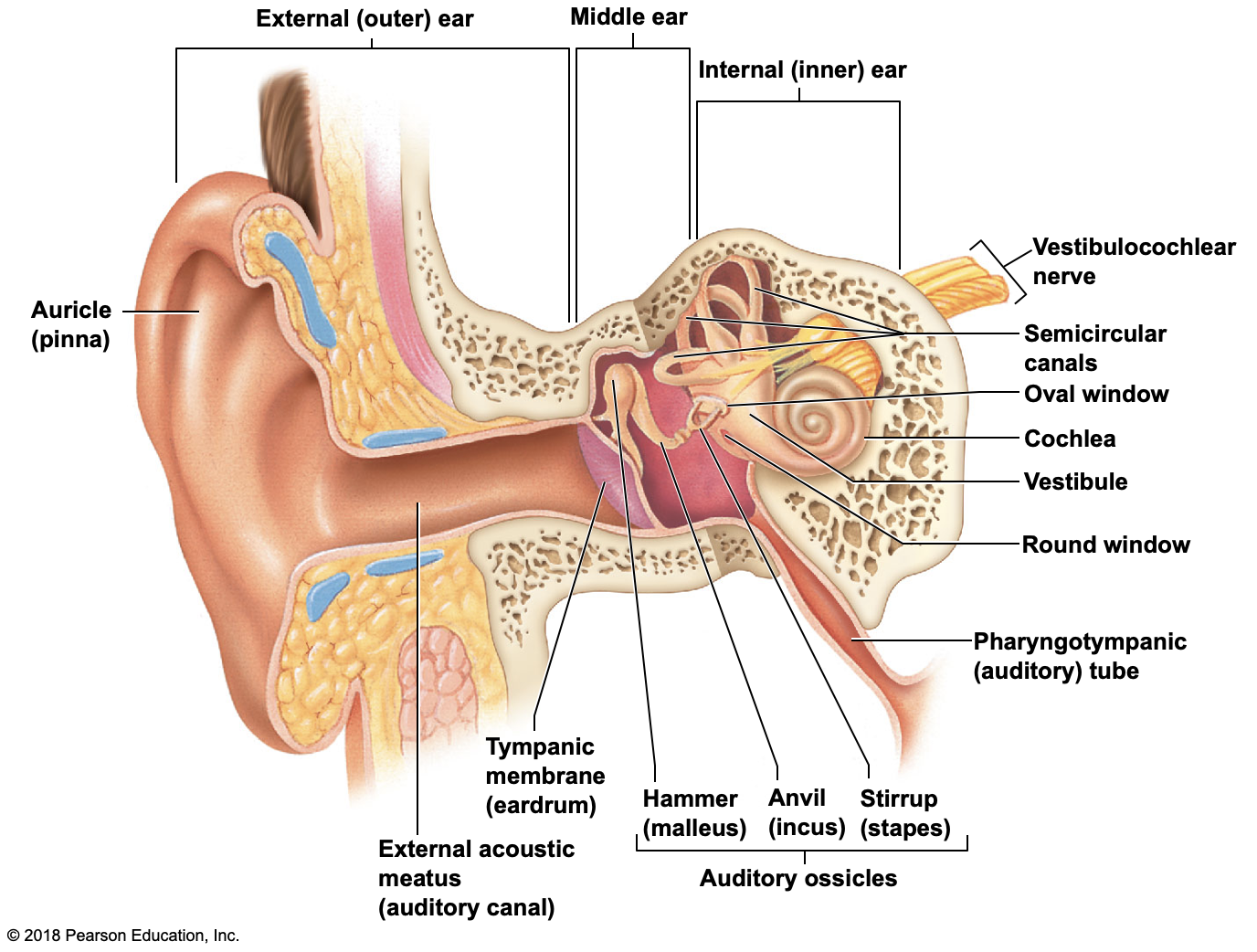Chapter 8- Special Senses
Special Senses
- Special senses include:
- Smell
- Taste
- Sight
- Hearing
- Equilibrium
- Special sense receptors
- Large, complex sensory organs
- Localized clusters of receptors
The Eye and Vision
- 70% of all sensory receptors are in the eyes
- Each eye has over 1 million nerve fibers carrying information to the brain
Anatomy of the Eye
- Accessory structures include the:
- Extrinsic eye muscles (operating from the outside)
- Eyelids
- Conjunctiva
- Lacrimal apparatus
External and Accessory Structures
- Eyelids
- Meet at the medial and lateral commissure (canthus)
- Eyelashes
- Tarsal glands produce an oily secretion that lubricates the eye
- Ciliary glands are located between the eyelashes
- Conjunctiva
- Membranes that lines the eyelids and eyeball
- Connects with the transparent cornea
- Secretes to lubricate the eye and keep it moist
- Lacrimal apparatus = lacrimal gland + ducts
- Lacrimal gland—produces lacrimal fluid (tears); situated on lateral end of each eye
- Tears drain across the eye into the lacrimal canaliculi, then the lacrimal sac, and into the nasolacrimal duct-, which empties into the nasal cavity
- Tears contain:
- Dilute salt solution (saline)
- Mucus
- Antibodies
- Lysozyme (enzyme that destroys bacteria)
- Function of tears
- Cleanse, protect, moisten, lubricate the eye
- Extrinsic eye muscles
- 6 muscle attach attach to the outer surface of the eye
- Produce gross eye movements
Internal Structures: The Eyeball
- Three layers, or tunics, form the wall of the eyeball
- Fibrous layer: outside layer
- Vascular layer: middle layer
- Sensory layer: inside layer
- Humors are fluids that fill the interior of the eyeball
- Lens divides the eye into two chambers
- Fibrous layer = sclera + cornea
- Sclera
- White connective tissue layer ”white of the eye”
- Cornea
- Transparent, central anterior portion
- Allows for light to pass through
- Repairs itself easily
- The only human tissue that can be transplanted without fear of rejection
- Vascular layer
- Choroid is a blood-rich nutritive layer that contains a pigment(prevents light from scattering) & is modified anteriorly into two smooth muscle structures
- Ciliary body
- Iris -—regulates amount of light entering eye
- Pigmented layer—gives eye color
- Pupil—rounded opening in the iris
- Sensory layer
- Retina contains two layers
- Outer pigmented layer absorbs light and prevents it from scattering
- Inner neural layer contains receptor cells (photoreceptors)
- Rods
- Cones
- Electrical signals pass from photoreceptors via a two-neuron chain
- Bipolar neuronsGanglion cells
- Signals leave the retina toward the brain through the optic nerve
- Optic disc- (blind spot) is where the optic nerve leaves the eyeball
- Cannot see images focused on the optic disc
- Rods
- Most are found toward the edges of the retina
- Allow vision in dim light and peripheral vision
- All perception is in gray tones
- Cones
- Allow for detailed color vision
- Densest in the center of the retina
- Fovea centralis–lateral to blind spot
- Area of the retina with only cones
- Visual acuity(sharpest vision) is here
- No photoreceptor cells are at the optic disc, or blind spot
- Cone sensitivity
- Three types of cones
- Each cone type is sensitive to different wavelengths of visible light
- Lens
- Flexible, biconvex (convex on both sides) crystal-like structure
- Held in place by a suspensory ligament attached to the ciliary body
- Lens divides the eye into two chambers
- Anterior (aqueous) segment
- Anterior to the lens
- Contains aqueous humor, a clear, watery fluid
- Posterior (vitreous) segment
- Posterior to the lens
- Contains vitreous humor, a gel-like substance
- Aqueous humor
- Watery fluid found between lens and cornea
- Similar to blood plasma
- Helps maintain intraocular pressure
- Provides nutrients for the lens and cornea
- Reabsorbed into venous blood through the scleral venous sinus, or canal of Schlemm
- Vitreous humor
- Gel- like substance posterior to the lens
- Prevents the eye from collapsing
- Helps maintain intraocular pressure
- Ophthalmoscope
- Instrument used to illuminate the interior of the eyeball and fundus (posterior wall)
- Can detect diabetes, arteriosclerosis, degeneration of the optic nerve and retina
Physiology of Vision
Path of light through eye & light refraction
- Light must be focused to a point on the retina for optimal vision
- Light is bent, or refracted, by the cornea, aqueous humor, lens, and vitreous humor
- The eye is set for distant vision (over 20 feet away)
- Accommodation—the lens must change shape to focus on closer objects (less than 20 feet away)

Pathway of light through the eye and light refraction (continued)
- Image formed on the retina is a real image
- Real images are:
- Reversed from left to right
- Upside down
- Smaller than the object

Visual fields and visual pathways to brain
- Optic nerve
- Bundle of axons that exit the back of the eye carrying impulses from the retina
- Optic chiasma
- Location where the optic nerves cross
- Fibers from the medial side of each eye cross over to the opposite side of the brain
Visual fields & visual pathways to the brain
- Optic tracts
- Contain fibers from the lateral side of the eye on the same side and the medial side of the opposite eye
- Synapse with neurons in the thalamus- (relaying of sensory signals, including motor signals, to the cerebral cortex, and the regulation of consciousness, sleep, and alertness)
- Optic radiation
- Axons from the thalamus run to the occipital lobe
- Synapse with cortical cells, and vision interpretation (seeing) occurs
Summary of the pathway of impulses from the retina to the point of visual interpretation
- Optic nerve
- Optic chiasma
- Optic tract
- Thalamus
- Optic radiation
- Optic cortex in occipital lobe of brain
Visual fields
- Each eye “sees” a slightly different view
- Field of view overlaps for each eye
Binocular vision results and provides:
- Depth perception (three-dimensional vision)

A Closer Look
Emmetropia—eye focuses images correctly on the retina
Myopia (nearsightedness)
- Distant objects appear blurry
- Light from those objects fail to reach the retina and are focused in front of it
- Results from an eyeball that is too long
Hyperopia (farsightedness)
- Near -objects are blurry, whereas distant objects are clear
- Distant objects are focused behind the retina
- Results from an eyeball that is too short or from a “lazy lens”
Astigmatism
- Images are blurry
- Results from light focusing as lines, not points, on the retina because of unequal curvatures of the cornea or lens
- Convergence: reflexive movement of the eyes medially when we focus on a close object
- Photopupillary reflex: bright light causes pupils to constrict
- Accommodation pupillary reflex: viewing close objects causes pupils to constrict

The Ear: Hearing and Balance
Ear houses two senses
- Hearing
- Equilibrium (balance)
Receptors are mechanoreceptors (respond to touch or feel)
Different organs house receptors for each sense
Anatomy of the Ear
- The ear is divided into three areas
- External (outer) ear
- Middle ear
- Internal (inner) ear
External (outer) ear
- Auricle (pinna)
- Ext. acoustic meatus (auditory canal)
- Narrow chamber in the temporal bone
- Lined with skin and ceruminous (earwax) glands
- Ends at the tympanic membrane (eardrum)
External ear is involved only in collecting sound waves
Middle ear cavity (tympanic cavity)
Air filled, mucosa-lined cavity within the temporal bone
Involved only in the sense of hearing
Located between tympanic membrane and oval window and round window
Pharyngotympanic tube (auditory tube)
Links middle ear cavity with the throat
Equalizes pressure in the middle ear cavity so the eardrum can vibrate
Middle ear cavity (tympanic cavity)
Three bones (ossicles) span the cavity
Malleus(hammer), Incus(anvil), Stapes(stirrup)
Function
Transmit vibration from tympanic membrane to the fluids of the inner ear
Vibrations travel: hammer -> anvil -> stirrup -> oval window of inner ear
Internal (inner) ear
Sense organs for hearing and balance
Bony labyrinth (osseous labryrinth) consists of:
Cochlea, vestibule, semicircular canals
Bony labyrinth is filled with perilymph
Membranous labyrinth is suspended in perilymph and contains endolymph

Equilibrium
Equilibrium receptors of the inner ear are called the vestibular apparatus
Vestibular apparatus has two functional parts
- Static equilibrium
- Dynamic equilibrium
Static Equilibrium
Maculae—receptors in the vestibule
- Report on the position of the head
- Help us keep our head erect
- Send information via the vestibular nerve (division of cranial nerve VIII) to the cerebellum of the brain

Anatomy of the maculae
- Hair cells are embedded in the otolithic membrane
- Otoliths (tiny stones) float in a gel around hair cells
- Movements cause otoliths to roll and bend hair cells
Dynamic Equilibrium
- Crista ampullaris
- Responds to angular or rotational of the head
- In ampulla of each semicircular canal
- Tuft of hair cells covered with cupula (gelatinous cap)
- If the head moves, the cupola drags against the endolymph
- Hair cells are stimulated, impulse travels vestibular n. to the cerebellum
Hearing
- Spiral organ of Corti
- Located within the cochlear duct
- Receptors = hair cells on the basilar membrane
- Gel-like tectorial membrane is capable of bending hair cells
- Cochlear nerve attached to hair cells transmits nerve impulses to auditory cortex on temporal lobe
- Pathway of vibrations from sound waves
- Ear drumossiclesoval window
- Sound is amplified by the ossicles
- Pressure waves cause vibrations in the basilar membrane in the organ of Corti
- Hair cells of the tectorial membrane are bent when the basilar membrane vibrates against it
- An action potential starts in the cochlear nerve (cranial nerve VIII), and the impulse travels to the temporal lobe
- High pitched sounds disturb the short, stiff fibers of the basilar membrane
- Receptor cells close to the oval window are stimulated
- Low pitched sounds disturb the long, floppy fibers of the basilar membrane
- Specific hair cells further along the cochlea are affected
Hearing and Equilibrium Deficits
- Deafness is any degree of hearing loss
- Conduction deafness results when the transmission of sound vibrations through the external and middle ears is hindered
- Sensorineural deafness results from damage to the nervous system structures involved in hearing
- Meniere’s affects inner ear and causes progressive deafness and perhaps vertigo (sensation of spinning)
Chemical Senses: Smell & Taste
- Chemoreceptors
- Stimulated by chemicals in solution
- Taste has five types of receptors
- Smell can differentiate a wider range of chemicals
- Both senses complement each other and respond to many of the same stimuli
Olfactory Receptors/Sense of Smell
- Olfactory receptors in roof of nasal cavity
- Olfactory receptor cells (neurons) with long cilia (olfactory hairs) detect chemicals
- Chemicals must be dissolved in mucus for detection by chemoreceptors called olfactory receptors
- Impulses are transmitted via the olfactory filaments to the olfactory nerve (I)
- Smells interpreted in the olfactory cortex
Taste Buds and Sense of Taste
- Taste buds house the receptor organs
- Locations of taste buds
- Most are on the tongue
- Soft palate
- Superior part of the pharynx
- Cheeks
- The tongue is covered with projections called papillae that contain taste buds
- Vallate (circumvallate) papillae
- Fungiform papillae
- Filiform papillae
- Gustatory cells are the taste receptors
- Possess gustatory hairs (long microvilli)
- Gustatory hairs protrude through a taste pore
- Hairs are stimulated by chemicals dissolved in saliva
- Impulses are carried to the gustatory complex by several cranial nerves because taste buds are found in different areas
- Facial nerve (cranial nerve VII)
- Glossopharyngeal nerve (cranial nerve IX)
- Vagus nerve (cranial nerve X)
- Taste buds are replaced frequently by basal cells
- Five basic taste sensations
- Sweet receptors respond to sugars, saccharine, some amino acids
- Sour receptors respond to H+ ions or acids
- Bitter receptors respond to alkaloids
- Salty receptors respond to metal ions
- Umami receptors respond to the amino acid glutamate or the beefy taste of meat
Developmental Aspects of the Special Senses
- Special sense organs are formed early in embryonic development
- Maternal infections during the first 5 or 6 weeks of pregnancy may cause visual abnormalities as well as sensorineural deafness in the developing child
- Vision requires the most learning
- The infant has poor visual acuity (is farsighted) and lacks color vision and depth perception at birth
- The eye continues to grow and mature until age 8 or 9
- Age-related eye issues
- Presbyopia—“old vision” results from decreasing lens elasticity that accompanies aging
- Difficulty to focus for close vision
- Lacrimal glands become less active
- Lens becomes discolored
- Dilator muscles of iris become less efficient, pupils remain constricted
- The newborn infant can hear sounds, but initial responses are reflexive
- By the toddler stage, the child is listening critically and beginning to imitate sounds as language development begins
- Age-related ear problems
- Presbycusis—type of sensorineural deafness that may result from otosclerosis (ear ossicles fuse)
- Congenital ear problems usually result from missing pinnas and closed or missing external acoustic meatuses
- Taste and smell are most acute at birth and decrease in sensitivity after age 40 as the number of olfactory and gustatory receptors decreases